Okay, the pageview teller of European Film Star Postcards passed the 5,000,000, but what does it mean? For us, it's a good excuse to update the five most popular posts of all times and to thank you for visiting our blog. And we are Paul van Yperen and partner-in-crime Ivo Blom. Today, the most popular post ever. It was many times updated, the last time on 3 July 2015. The stats says 26,049 pageviews.
A highlight at Il Cinema Ritrovato 2015 is the open-air screening tonight of Rocco e i suoi fratelli/Rocco and His Brothers (Luchino Visconti, 1960) in a magical black and white, thanks to a new restoration. Today's post is about Alain Delon (1935), the actor who played Rocco in this landmark Italian film. Delon was the breathtakingly good-looking James Dean of the European cinema of the late 1950s and early 1960s who proved in this film that he was also a magnificent actor.
Image may be NSFW.
Clik here to view.
East-German postcard by VEB Progress Film-Vertrieb, Berlin, 1967. retail price: 0,20 MDN.Photo: publicity still for Rocco e i suoi fratelli/Rocco and his brothers (Luchino Visconti, 1960).
Image may be NSFW.
Clik here to view.
French postcard by E.D.U.G., no. 22. Photo: Sam Lévin.
Image may be NSFW.
Clik here to view.
German postcard by Krüger. Photo: Ufa.
Image may be NSFW.
Clik here to view.
German postcard by ISV, no. H 25.
Image may be NSFW.
Clik here to view.
French postcard by St. Anne, Marseille. Photo: Sam Lévin.
Image may be NSFW.
Clik here to view.
Spanish postcard, no. 161. Photo: Philippe R. Doumic.
Image may be NSFW.
Clik here to view.
Spanish postcard by Bergas Ind. Graf., Barcelona, no. 463, 1967.
Alain Fabien Maurice Marcel Delon was born in Sceaux, a suburb of Paris in 1935. His parents, Édith Arnold and Fabien Delon, divorced when Delon was four. He had a stormy childhood and was six times expelled from different schools.
At 14, Delon left school, and worked for a brief time at his stepfather Paul Boulogne's butcher shop. Three years later, the 17-year-old enlisted in the French Marines, serving in 1953-1954 in Indochina as a parachutist. In 1956, after being dishonourably discharged from the military, he returned to France. He had little money and worked at various odd jobs, including as a waiter, salesman, and porter in the Les Halles market.
During this time he became friends with the actress Brigitte Auber, and joined her on a trip to the Cannes Film Festival, where his film career would begin with a screentest for David O’Selznick. He didn't go to Hollywood, but decided to stay in France. He made his film debut in Quand la femmes s'en mele/Send a Woman When the Devil Fails (Yves Allégret, 1957).
In 1958, during the making of the love story Christine (Pierre Gaspard-Huit, 1959), Delon met Romy Schneider. They would be engaged till 1964.
Delon’s first outstanding success came with the role of the parasite Tom Ripley in the sundrenched thriller Plein soleil/Purple Noon (René Clément, 1960), based on the crime novel The Talented Mr. Ripley by Patricia Highsmith. Delon presented a psychological portrait of a murderous young cynic who attempts to take on the identity of his victim. The critics liked his performance. According to Wikipedia, Patricia Highsmith herself was also a fan of his portrayal.
Image may be NSFW.
Clik here to view.
German postcard by WS-Druck, Wanne Eickel, no. 419. Photo: Sam Lévin, 1957.
Image may be NSFW.
Clik here to view.
French postcard by Editions P.I., no. 1004. Offered by Les Carbones Korès 'Carboplane'. Photo: Sam Lévin.
Image may be NSFW.
Clik here to view.
French postcard by Editions P.I., no. 1026. Photo: Sam Lévin.
Image may be NSFW.
Clik here to view.
Belgian postcard by D.R.C, licency holder for Belgium and Belgian Congo of Universum Film Aktiengesellschaft, Berlin-Tempelhof, no. 4615. Photo: Sam Lévin / Ufa.
Image may be NSFW.
Clik here to view.![Alain Delon]()
Dutch postcard by Muziekparade, Hilversum, no. AX 4701. Photo: Hafbo / Sam Lévin.
Image may be NSFW.
Clik here to view.![Happy birthday, Alain Delon!]()
French postcard by Editions du Globe (EDUG), Paris, no. 838. Photo: Sam Lévin.
Image may be NSFW.
Clik here to view.![Alain Delon]()
Dutch postcard by Uitg. Takken, Utrecht, no. 3980. Photo: N.V. Meteor Film / Speva / Play Art Prod. Publicity still for Christine/Liebelei (Pierre Gaspard-Huit, 1958).
Luchino Visconti offered Alain Delon a totally different role in Rocco e i suoi fratelli/Rocco and His Brothers (Luchino Visconti, 1960). In this film, he plays the devoted Sicilian immigrant Rocco, who accepts the greatest sacrifices to save his characterless brother Simone, played by Renato Salvatori. Delon received international recognition for this role.
The following year Alain Delon made his stage debut in Paris in Dommage qu'elle soit une putain/'Tis Pity She’s a Whore, alongside Romy Schneider. The play, written by John Ford, was directed by Luchino Visconti. The production cost a reported 60 million francs and broke box office records. It ran for more than 8 months.
Delon also gave tremendous performances in L'Eclisse/The Eclipse (Michelangelo Antonioni, 1962) opposite Monica Vitti, and the epic Il Gattopardo/The Leopard (Luchino Visconti, 1963) starring opposite Burt Lancaster and Claudia Cardinale. L’Eclisse won the Special Prize of the jury at the Cannes Film Festival, and the following year Il Gattopardo won the Golden Palm in Cannes.
After these acclaimed Italian films, Alain Delon returned to France and to the crime film in Mélodie en sous-sol/The Big Snatch (Henri Verneuil, 1963), with Jean Gabin. This classic genre film was distinguished by a soundly worked-out screenplay, by careful production and by excellent performances of both Gabin and Delon.
Image may be NSFW.
Clik here to view.![Alain Delon]()
Dutch postcard by Gebr. Spanjersberg, Rotterdam, no. 1383. Photo: Unifrance Film / Ufa.
Image may be NSFW.
Clik here to view.![Alain Delon]()
French postcard by Editions P.I., Paris, no. FK 44. Photo: Unifrance / Ufa.
Image may be NSFW.
Clik here to view.![Alain Delon]()
Dutch postcard by 't Sticht, Utrecht, no. 6176.
Image may be NSFW.
Clik here to view.![Alain Delon]()
German postcard by WS-Druck, Wanne-Eickel, no. 444. Photo: Privat.
Image may be NSFW.
Clik here to view.![Alain Delon]()
French postcard by Editions P.I., Paris, no. FK 42. Photo: Unifrance Film / Philippe R. Doumic.
Image may be NSFW.
Clik here to view.![Alain Delon]()
French postcard by Editions P.I., no. 1151A, offered by Les Carbones Korès 'Carboplane.
Image may be NSFW.
Clik here to view.![Happy birthday, Alain Delon!]()
French postcard by Editions P.I., no. 1161, offered by Les Carbones Korès 'Carboplane. Photo: Pierre Manciet.
By now Hollywood studios were very interested in Alain Delon and he decided to make a bid for American stardom. In 1965, MGM signed him to a five picture contract. The first movie of this deal was Les Félins/Joy House (René Clément, 1964), shot in France with Jane Fonda. He followed it up with two more films for the studio: the all-star The Yellow Rolls Royce (Anthony Asquith, 1965), in which Delon had a relatively small role, and Once a Thief (Ralph Nelson, 1965), where he co-starred with Ann-Margret.
Delon then signed a three picture deal with Columbia. He appeared for this studio in the big budget action film Lost Command (Mark Robson, 1966) with Anthony Quinn. Universal Studios used Delon in the Western Texas Across the River (Michael Gordon, 1966), opposite Dean Martin.
For Seven Arts, Delon starred in Paris brûle-t-il?/Is Paris Burning? (René Clément, 1966) about the liberation of Paris in August 1944 by the French Resistance and the Free French Forces. This was a massive hit in France but it performed disappointingly at the US box office - as did all of Delon's Hollywood financed films. So after six Hollywood movies Delon returned to France.
In the late sixties, Delon came to epitomise the calm, psychopathic hoodlum, staring into the camera like a cat assessing a mouse. His tough, ruthless side was used to grand effect in Le Samouraï/The Godson (Jean-Pierre Melville, 1967), maybe Delon’s finest moment. Later Melville directed him again in the crime films Le Cercle Rouge/The Red Circle (1970) with Bourvil and Yves Montand, and Un Flic/A Cop (1972) with Catherine Deneuve.
In 1968 Delon also in real life got involved in a murder scandal when one of his bodyguard was found shot dead on a garbage dump nearby Delon's house. Eventually Delon was cleared of all charges.
In the cinema, Alain Delon had a huge success in the bloodstained Borsalino (Jacques Deray, 1970). He and Jean-Paul Belmondo played small-time gangsters who become kings of the Marseilles underworld of the 1930s. He also produced Borsalino, and the film became one of France’s highest grossing films of the time. Between 1968 and 1990 he went on to produce 26 films.
Image may be NSFW.
Clik here to view.![Alain Delon and Romy Schneider in Christine]()
Dutch postcard by Takken, Utrecht. Photo: NV Meteor Film. Publicity still for Christine/Liebelei (Pierre Gaspard-Huit, 1958) with Romy Schneider.
Image may be NSFW.
Clik here to view.![Alain Delon]()
French postcard by the Bibliothèque Nationale Paris / Imp. Bussière A.G., Paris, 1990. Photo: Roger Pic. Alain Delon in the play Dommage qu'elle soit une p.../'Tis Pity She’s a Whore directed by Luchino Visconti (1961).
Image may be NSFW.
Clik here to view.![Alain Delon, Brigitte Bardot]()
German postcard by Krüger, no. 902/95. Photo Sam Lévin. Another sexy publicity photo for Amours célèbres (Michel Boisrond, 1961) with Brigitte Bardot.
Image may be NSFW.
Clik here to view.![Monica Vitti and Alain Delon in L'eclisse, 1962]()
Small Romanian collectors card by Casa Filmului Acin. Photo: publicity still for L'eclisse/The Eclypse (Michelangelo Antonioni, 1962) with Monica Vitti.
Image may be NSFW.
Clik here to view.![Alain Delon and Shirley MacLaine in The Yellow Rolls-Royce (1964)]()
Romanian postcard by Casa Filmului Acin, no. 313. Photo: publicity still for The Yellow Rolls-Royce (Anthony Asquith, 1964) with Shirley MacLaine.
Image may be NSFW.
Clik here to view.![Nathalie and Alain Delon in Le Samouraï]()
Small Romanian collectors card. Photo: publicity still for Le Samouraï (Jean-Pierre Melville, 1967) with Nathalie Delon.
Image may be NSFW.
Clik here to view.![Catherine Deneuve and Alain Delon in Le choc (1982)]()
Romanian postcard by Casa Filmului Acin. Photo: publicity still for Le choc/Shock (Robin Davis, 1982) with Catherine Deneuve.
In later years Alain Delon won critical acclaim for roles against type. In the Kafkaesk thriller Mr Klein (Joseph Losey, 1976) he was brilliant as the icily sinister art trader in German-occupied France.
In 1985 he was awarded the César Award as Best Actor for his role as an alcoholic in Notre histoire/Our Story (Bertrand Blier, 1984). Another acclaimed role was the homosexual Baron de Charlus in the fine Marcel Proust adaptation Un amour de Swann/Swann in Love (Volker Schlöndorf, 1984).
And in 1990, Delon worked with New Wave auteur Jean-Luc Godard on Nouvelle vague/New Wave (1990), in which he played twins. He also directed two films himself, Pour la peau d'un flic/For a Cop's Hide (1981) and Le Battant/The Fighter (1983).
A string of box office disasters in the next years culminated in 1998 in the unexpected failure of Une chance sur deux/Half a Chance (Patrice Leconte, 1998) in which Alain Delon was reunited with Jean-Paul Belmondo. Delon announced that he would give up acting. For his impressive film career he received the Legion d'Honneur, the highest French decoration.
Image may be NSFW.
Clik here to view.![Alain Delon]()
French postcard by E.D.U.G., no. 469. Photo: Sam Lévin.
Image may be NSFW.
Clik here to view.![Alain Delon]()
Spanish postcard by Bergas Ind. Graf., no. 572.
Image may be NSFW.
Clik here to view.![Alain Delon]()
Romanian postcard by Casa Filmului Acin.
Image may be NSFW.
Clik here to view.![Alain Delon]()
Romanian postcard by Casa Filmului Acin.
Image may be NSFW.
Clik here to view.![Happy birthday, Alain Delon!]()
Romanian postcard by Casa Filmului Acin.
Image may be NSFW.
Clik here to view.![Alain Delon]()
French postcard by Editions F. Nugeron, no. Star 28.
Image may be NSFW.
Clik here to view.![Alain Delon]()
French postcard by Editions P.I., Paris, no. 3453. Photo: Michel Ginfray.
Alain Delon returned in the cinema as Julius Cesarin Astérix aux Jeux Olympiques/Asterix at the Olympic Games (Frederic Forestier, Thomas Langmann, 2008), and he reunited with former girlfriend Mireille Darc in a stage adaptation of The Bridges of Madison County by Robert James Waller at the Marigny Theatre in Paris.
Alain Delon has a son, Christian Aaron Boulogne 'Ari' Päffgen (1962), from a relationship with German singer/supermodel Nico. The child was raised mostly by Delon's mother and stepfather. He broke the relationship with his mother after she insisted on taking care of Ari. They spoke again when his step-father died in 1988, the same year Nico died.
From his first marriage to Nathalie Delon (Nathalie Barthélemy) he has another son, Anthony Delon (1964), who also acted in a number of films. Then he was a longtime companion of actress Mireille Darc from 1968 to 1982. Then he had a relationship with Anne Parillaud. From his second marriage with former Dutch model Rosalie van Breemen he has a son Alain-Fabien (1990) and a daughter Anouchka (1994). Rosalie was 21 when she met Alain who was 52. They lived together from 1987 till 2001.
Today, Alain Delon lives in Geneva, Switzerland. He acquired Swiss citizenship in 1999, and the company managing products sold under his name is based in Geneva. Since the formation of a perfume label in his name, Delon has had a variety of products sold under his name including wristwatches, clothing, eyewear, stationery and cigarettes.
His most recent film appearance was in the Russian comedy S Novym godom, mamy!/Happy New Year, Mommies! (Artyom Aksyonenko, Sarik Andreasyan, Anton Bormatov, Dmitriy Grachev, Klim Poplavskiy, 2012).
Trailer Rocco e i suoi fratelli/Rocco and his Brothers (1960). Source: Filmmuseum Amsterdam (YouTube).
Trailer for Mélodie en sous-sol/The Big Snatch (1963). Source: Curtis Hayden (YouTube).
Trailer Le Samouraï/The Godson (1967). Source: Edwin Nieves (YouTube).
Trailer La Piscine/The Pool (1968). Source: Filmmuseum Amsterdam (YouTube).
Sources: Alain Delon.ch, Wikipedia, Sarah (IMDb), Il Cinema Ritrovato and IMDb.
A highlight at Il Cinema Ritrovato 2015 is the open-air screening tonight of Rocco e i suoi fratelli/Rocco and His Brothers (Luchino Visconti, 1960) in a magical black and white, thanks to a new restoration. Today's post is about Alain Delon (1935), the actor who played Rocco in this landmark Italian film. Delon was the breathtakingly good-looking James Dean of the European cinema of the late 1950s and early 1960s who proved in this film that he was also a magnificent actor.
Image may be NSFW.
Clik here to view.

East-German postcard by VEB Progress Film-Vertrieb, Berlin, 1967. retail price: 0,20 MDN.Photo: publicity still for Rocco e i suoi fratelli/Rocco and his brothers (Luchino Visconti, 1960).
Image may be NSFW.
Clik here to view.
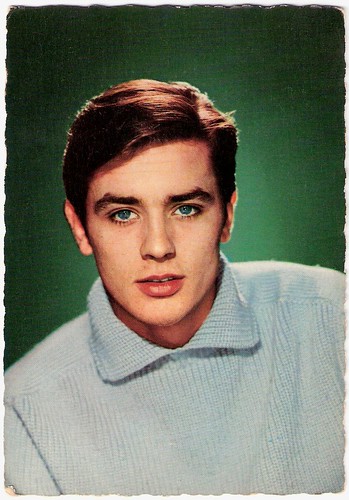
French postcard by E.D.U.G., no. 22. Photo: Sam Lévin.
Image may be NSFW.
Clik here to view.
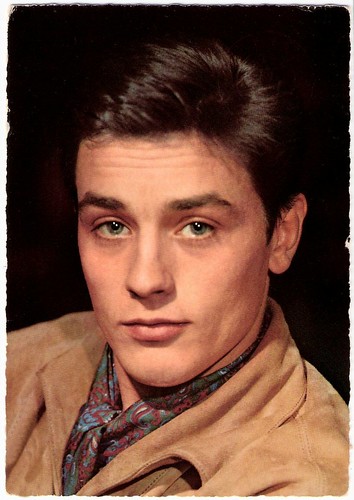
German postcard by Krüger. Photo: Ufa.
Image may be NSFW.
Clik here to view.
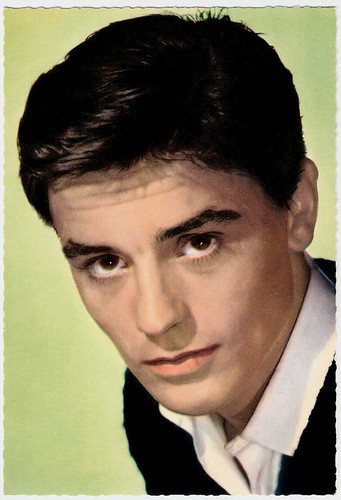
German postcard by ISV, no. H 25.
Image may be NSFW.
Clik here to view.

French postcard by St. Anne, Marseille. Photo: Sam Lévin.
Image may be NSFW.
Clik here to view.

Spanish postcard, no. 161. Photo: Philippe R. Doumic.
Image may be NSFW.
Clik here to view.

Spanish postcard by Bergas Ind. Graf., Barcelona, no. 463, 1967.
Stormy Childhood
Alain Fabien Maurice Marcel Delon was born in Sceaux, a suburb of Paris in 1935. His parents, Édith Arnold and Fabien Delon, divorced when Delon was four. He had a stormy childhood and was six times expelled from different schools.
At 14, Delon left school, and worked for a brief time at his stepfather Paul Boulogne's butcher shop. Three years later, the 17-year-old enlisted in the French Marines, serving in 1953-1954 in Indochina as a parachutist. In 1956, after being dishonourably discharged from the military, he returned to France. He had little money and worked at various odd jobs, including as a waiter, salesman, and porter in the Les Halles market.
During this time he became friends with the actress Brigitte Auber, and joined her on a trip to the Cannes Film Festival, where his film career would begin with a screentest for David O’Selznick. He didn't go to Hollywood, but decided to stay in France. He made his film debut in Quand la femmes s'en mele/Send a Woman When the Devil Fails (Yves Allégret, 1957).
In 1958, during the making of the love story Christine (Pierre Gaspard-Huit, 1959), Delon met Romy Schneider. They would be engaged till 1964.
Delon’s first outstanding success came with the role of the parasite Tom Ripley in the sundrenched thriller Plein soleil/Purple Noon (René Clément, 1960), based on the crime novel The Talented Mr. Ripley by Patricia Highsmith. Delon presented a psychological portrait of a murderous young cynic who attempts to take on the identity of his victim. The critics liked his performance. According to Wikipedia, Patricia Highsmith herself was also a fan of his portrayal.
Image may be NSFW.
Clik here to view.

German postcard by WS-Druck, Wanne Eickel, no. 419. Photo: Sam Lévin, 1957.
Image may be NSFW.
Clik here to view.

French postcard by Editions P.I., no. 1004. Offered by Les Carbones Korès 'Carboplane'. Photo: Sam Lévin.
Image may be NSFW.
Clik here to view.
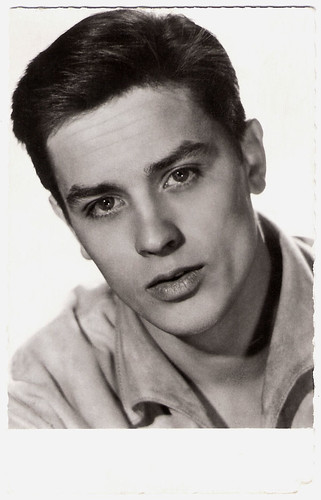
French postcard by Editions P.I., no. 1026. Photo: Sam Lévin.
Image may be NSFW.
Clik here to view.

Belgian postcard by D.R.C, licency holder for Belgium and Belgian Congo of Universum Film Aktiengesellschaft, Berlin-Tempelhof, no. 4615. Photo: Sam Lévin / Ufa.
Image may be NSFW.
Clik here to view.

Dutch postcard by Muziekparade, Hilversum, no. AX 4701. Photo: Hafbo / Sam Lévin.
Image may be NSFW.
Clik here to view.

French postcard by Editions du Globe (EDUG), Paris, no. 838. Photo: Sam Lévin.
Image may be NSFW.
Clik here to view.

Dutch postcard by Uitg. Takken, Utrecht, no. 3980. Photo: N.V. Meteor Film / Speva / Play Art Prod. Publicity still for Christine/Liebelei (Pierre Gaspard-Huit, 1958).
The Eclipse
Luchino Visconti offered Alain Delon a totally different role in Rocco e i suoi fratelli/Rocco and His Brothers (Luchino Visconti, 1960). In this film, he plays the devoted Sicilian immigrant Rocco, who accepts the greatest sacrifices to save his characterless brother Simone, played by Renato Salvatori. Delon received international recognition for this role.
The following year Alain Delon made his stage debut in Paris in Dommage qu'elle soit une putain/'Tis Pity She’s a Whore, alongside Romy Schneider. The play, written by John Ford, was directed by Luchino Visconti. The production cost a reported 60 million francs and broke box office records. It ran for more than 8 months.
Delon also gave tremendous performances in L'Eclisse/The Eclipse (Michelangelo Antonioni, 1962) opposite Monica Vitti, and the epic Il Gattopardo/The Leopard (Luchino Visconti, 1963) starring opposite Burt Lancaster and Claudia Cardinale. L’Eclisse won the Special Prize of the jury at the Cannes Film Festival, and the following year Il Gattopardo won the Golden Palm in Cannes.
After these acclaimed Italian films, Alain Delon returned to France and to the crime film in Mélodie en sous-sol/The Big Snatch (Henri Verneuil, 1963), with Jean Gabin. This classic genre film was distinguished by a soundly worked-out screenplay, by careful production and by excellent performances of both Gabin and Delon.
Image may be NSFW.
Clik here to view.

Dutch postcard by Gebr. Spanjersberg, Rotterdam, no. 1383. Photo: Unifrance Film / Ufa.
Image may be NSFW.
Clik here to view.

French postcard by Editions P.I., Paris, no. FK 44. Photo: Unifrance / Ufa.
Image may be NSFW.
Clik here to view.

Dutch postcard by 't Sticht, Utrecht, no. 6176.
Image may be NSFW.
Clik here to view.

German postcard by WS-Druck, Wanne-Eickel, no. 444. Photo: Privat.
Image may be NSFW.
Clik here to view.

French postcard by Editions P.I., Paris, no. FK 42. Photo: Unifrance Film / Philippe R. Doumic.
Image may be NSFW.
Clik here to view.

French postcard by Editions P.I., no. 1151A, offered by Les Carbones Korès 'Carboplane.
Image may be NSFW.
Clik here to view.

French postcard by Editions P.I., no. 1161, offered by Les Carbones Korès 'Carboplane. Photo: Pierre Manciet.
A bid for American stardom
By now Hollywood studios were very interested in Alain Delon and he decided to make a bid for American stardom. In 1965, MGM signed him to a five picture contract. The first movie of this deal was Les Félins/Joy House (René Clément, 1964), shot in France with Jane Fonda. He followed it up with two more films for the studio: the all-star The Yellow Rolls Royce (Anthony Asquith, 1965), in which Delon had a relatively small role, and Once a Thief (Ralph Nelson, 1965), where he co-starred with Ann-Margret.
Delon then signed a three picture deal with Columbia. He appeared for this studio in the big budget action film Lost Command (Mark Robson, 1966) with Anthony Quinn. Universal Studios used Delon in the Western Texas Across the River (Michael Gordon, 1966), opposite Dean Martin.
For Seven Arts, Delon starred in Paris brûle-t-il?/Is Paris Burning? (René Clément, 1966) about the liberation of Paris in August 1944 by the French Resistance and the Free French Forces. This was a massive hit in France but it performed disappointingly at the US box office - as did all of Delon's Hollywood financed films. So after six Hollywood movies Delon returned to France.
In the late sixties, Delon came to epitomise the calm, psychopathic hoodlum, staring into the camera like a cat assessing a mouse. His tough, ruthless side was used to grand effect in Le Samouraï/The Godson (Jean-Pierre Melville, 1967), maybe Delon’s finest moment. Later Melville directed him again in the crime films Le Cercle Rouge/The Red Circle (1970) with Bourvil and Yves Montand, and Un Flic/A Cop (1972) with Catherine Deneuve.
In 1968 Delon also in real life got involved in a murder scandal when one of his bodyguard was found shot dead on a garbage dump nearby Delon's house. Eventually Delon was cleared of all charges.
In the cinema, Alain Delon had a huge success in the bloodstained Borsalino (Jacques Deray, 1970). He and Jean-Paul Belmondo played small-time gangsters who become kings of the Marseilles underworld of the 1930s. He also produced Borsalino, and the film became one of France’s highest grossing films of the time. Between 1968 and 1990 he went on to produce 26 films.
Image may be NSFW.
Clik here to view.
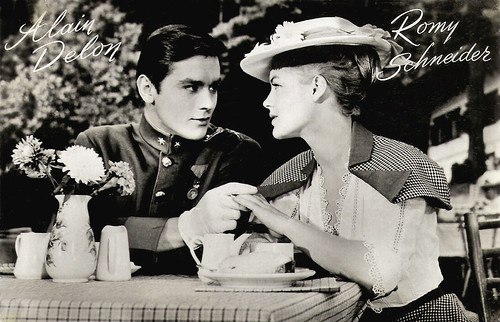
Dutch postcard by Takken, Utrecht. Photo: NV Meteor Film. Publicity still for Christine/Liebelei (Pierre Gaspard-Huit, 1958) with Romy Schneider.
Image may be NSFW.
Clik here to view.

French postcard by the Bibliothèque Nationale Paris / Imp. Bussière A.G., Paris, 1990. Photo: Roger Pic. Alain Delon in the play Dommage qu'elle soit une p.../'Tis Pity She’s a Whore directed by Luchino Visconti (1961).
Image may be NSFW.
Clik here to view.
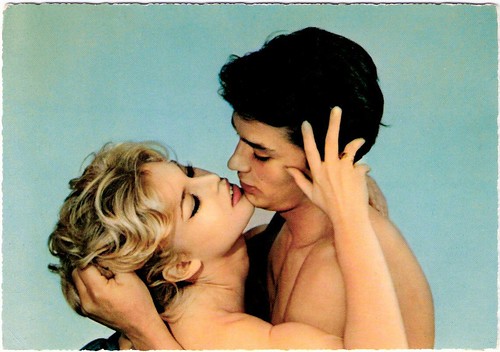
German postcard by Krüger, no. 902/95. Photo Sam Lévin. Another sexy publicity photo for Amours célèbres (Michel Boisrond, 1961) with Brigitte Bardot.
Image may be NSFW.
Clik here to view.

Small Romanian collectors card by Casa Filmului Acin. Photo: publicity still for L'eclisse/The Eclypse (Michelangelo Antonioni, 1962) with Monica Vitti.
Image may be NSFW.
Clik here to view.

Romanian postcard by Casa Filmului Acin, no. 313. Photo: publicity still for The Yellow Rolls-Royce (Anthony Asquith, 1964) with Shirley MacLaine.
Image may be NSFW.
Clik here to view.

Small Romanian collectors card. Photo: publicity still for Le Samouraï (Jean-Pierre Melville, 1967) with Nathalie Delon.
Image may be NSFW.
Clik here to view.

Romanian postcard by Casa Filmului Acin. Photo: publicity still for Le choc/Shock (Robin Davis, 1982) with Catherine Deneuve.
Roles Against Type
In later years Alain Delon won critical acclaim for roles against type. In the Kafkaesk thriller Mr Klein (Joseph Losey, 1976) he was brilliant as the icily sinister art trader in German-occupied France.
In 1985 he was awarded the César Award as Best Actor for his role as an alcoholic in Notre histoire/Our Story (Bertrand Blier, 1984). Another acclaimed role was the homosexual Baron de Charlus in the fine Marcel Proust adaptation Un amour de Swann/Swann in Love (Volker Schlöndorf, 1984).
And in 1990, Delon worked with New Wave auteur Jean-Luc Godard on Nouvelle vague/New Wave (1990), in which he played twins. He also directed two films himself, Pour la peau d'un flic/For a Cop's Hide (1981) and Le Battant/The Fighter (1983).
A string of box office disasters in the next years culminated in 1998 in the unexpected failure of Une chance sur deux/Half a Chance (Patrice Leconte, 1998) in which Alain Delon was reunited with Jean-Paul Belmondo. Delon announced that he would give up acting. For his impressive film career he received the Legion d'Honneur, the highest French decoration.
Image may be NSFW.
Clik here to view.
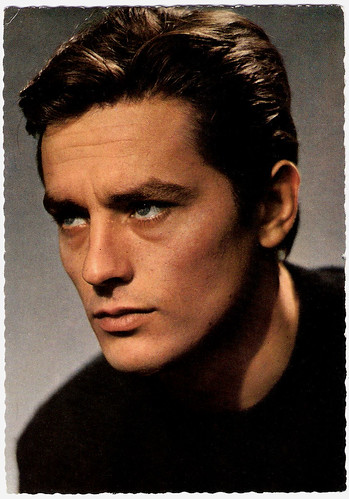
French postcard by E.D.U.G., no. 469. Photo: Sam Lévin.
Image may be NSFW.
Clik here to view.

Spanish postcard by Bergas Ind. Graf., no. 572.
Image may be NSFW.
Clik here to view.

Romanian postcard by Casa Filmului Acin.
Image may be NSFW.
Clik here to view.

Romanian postcard by Casa Filmului Acin.
Image may be NSFW.
Clik here to view.

Romanian postcard by Casa Filmului Acin.
Image may be NSFW.
Clik here to view.

French postcard by Editions F. Nugeron, no. Star 28.
Image may be NSFW.
Clik here to view.

French postcard by Editions P.I., Paris, no. 3453. Photo: Michel Ginfray.
Astérix
Alain Delon returned in the cinema as Julius Cesarin Astérix aux Jeux Olympiques/Asterix at the Olympic Games (Frederic Forestier, Thomas Langmann, 2008), and he reunited with former girlfriend Mireille Darc in a stage adaptation of The Bridges of Madison County by Robert James Waller at the Marigny Theatre in Paris.
Alain Delon has a son, Christian Aaron Boulogne 'Ari' Päffgen (1962), from a relationship with German singer/supermodel Nico. The child was raised mostly by Delon's mother and stepfather. He broke the relationship with his mother after she insisted on taking care of Ari. They spoke again when his step-father died in 1988, the same year Nico died.
From his first marriage to Nathalie Delon (Nathalie Barthélemy) he has another son, Anthony Delon (1964), who also acted in a number of films. Then he was a longtime companion of actress Mireille Darc from 1968 to 1982. Then he had a relationship with Anne Parillaud. From his second marriage with former Dutch model Rosalie van Breemen he has a son Alain-Fabien (1990) and a daughter Anouchka (1994). Rosalie was 21 when she met Alain who was 52. They lived together from 1987 till 2001.
Today, Alain Delon lives in Geneva, Switzerland. He acquired Swiss citizenship in 1999, and the company managing products sold under his name is based in Geneva. Since the formation of a perfume label in his name, Delon has had a variety of products sold under his name including wristwatches, clothing, eyewear, stationery and cigarettes.
His most recent film appearance was in the Russian comedy S Novym godom, mamy!/Happy New Year, Mommies! (Artyom Aksyonenko, Sarik Andreasyan, Anton Bormatov, Dmitriy Grachev, Klim Poplavskiy, 2012).
Trailer Rocco e i suoi fratelli/Rocco and his Brothers (1960). Source: Filmmuseum Amsterdam (YouTube).
Trailer for Mélodie en sous-sol/The Big Snatch (1963). Source: Curtis Hayden (YouTube).
Trailer Le Samouraï/The Godson (1967). Source: Edwin Nieves (YouTube).
Trailer La Piscine/The Pool (1968). Source: Filmmuseum Amsterdam (YouTube).
Sources: Alain Delon.ch, Wikipedia, Sarah (IMDb), Il Cinema Ritrovato and IMDb.